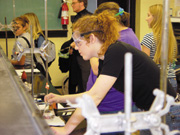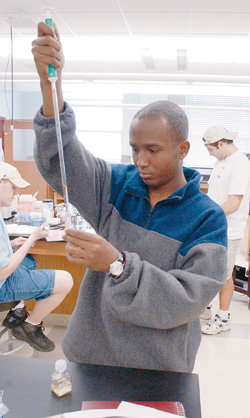|
Could it be
that thinking deeply about subjects such as history,
philosophy, and religion makes one a better scientist?
Wabash and many other top American schools think
so.
In 1665, an apple
fell from a tree and landed near young Isaac Newton.
Untold numbers of people had seen apples fall and
hadn’t given the matter a second thought.
But Newton pondered the phenomenon and developed
a cornerstone of modern science—the theory
of gravity.
The ability to ask
deep questions and look for answers lies at the
heart of science. So it stands to reason that educators
would want to bottle Newton’s brand of thinking
and serve it to their students.
Common sense might
argue that the best means to that end is to stuff
future scientists with chemistry, physics, biology,
and mathematics. After all, Newton had an insatiable
appetite for science. But Newton owned more books
in the humanities than he did in the sciences, and
his interests outside of physics and mathematics
included religion, ancient history, and Greek mythology.
Could it be that
thinking deeply about subjects such as history,
philosophy, and religion makes one a better scientist?
Wabash and many other top American schools think
so.
“A
Diversified Toolbox”
“Liberal
arts is counterintuitive,” says Mauri Ditzler
’75, Dean of Wabash College and a chemist
by training. “The liberal arts education is
a diversified toolbox. If you have only one way
of looking at things, you will get stuck in the
same place everybody else got stuck. If you’ve
got different experiences, you may find other ways
of solving the problem.”
It’s well
known that the fine-tuning of our brains is a “use
it or lose it” proposition. The more we think,
the better our neural connections. But liberal arts
colleges take that logic one step further. Advocates
of a cross-disciplinary education argue that learning
to think in one field may sharpen the ability to
solve complex problems in a seemingly unrelated
arena. It may be awhile before neuroscientists establish
the truth or falsity of this idea. In the meantime,
some of the best minds in science are betting that
it’s true.
“Learning about
the great books and the humanities can stimulate
the sort of brain waves that serve a scientist pretty
darn well,” said Tom Cech, a Nobel laureate
in chemistry and a graduate of Grinnell College.
“The more types of thinking you have to do,
the more skills you can bring to a scientific problem.
“Are taking
all these liberal arts courses a waste of time,
or is it important in developing your ability to
think by cross-training in these other topics? I’m
of the belief that it’s not a waste of time…You
could get more science if you went to a trade school,
but ultimately that may not produce the best scientists.
“You grow the
most when you’re hit from something in a different
direction,” says Cech, who now heads the Howard
Hughes Medical Institute. “You could study
chemistry, chemistry, and chemistry. But there’s
a point of diminishing returns.”
Cech’s own
study of top liberal arts colleges, published in
the journal Daedalus, produced a startling finding.
On average, these colleges produced far more science
Ph.D.’s per hundred bachelors degree graduates
than did big research universities. For every 100
Swarthmore graduates, 18 go on to earn science or
engineering Ph.Ds. For Carleton, it’s 15,
for Reed, 14.
Now look at a sampling
of major research universities. For the University
of Chicago, it’s 13, for Harvard 11, for Stanford
8, for Berkeley 7, for Michigan 5, and for Columbia
2. Only Cal Tech, M.I.T, and Harvey Mudd, all technical
institutions, outperform the top three liberal arts
colleges. The study covered a five-year period from
1991-1995.
A similar study conducted
in the 1980s named Wabash to “the Oberlin
Group”—48 “outstanding science-active
liberal arts colleges” that produce not only
excellent research but also, by percentages, over
three times as many science graduates as all colleges
and universities.
It would stand to
reason that the big players—including the
major state universities—might want to mimic
a Wabash or Carleton and use liberal arts training
as a springboard for science. Some try. Yet big
schools may not be able to duplicate all the advantages
of a small one, even though they have more equipment,
famous faculty, and often work on cutting-edge research
that can’t be done at Wabash and its peer
schools.
Size Matters
 It
could be the little things that make the difference.
For instance, at Wabash, professors don’t
just teach. They also serve as mentors and role
models. “You don’t just see our professors
for a 50-minute lecture,” says Ditzler. “You
are apt to run into them at concerts, basketball
games, or in the library. At a liberal arts college,
the student gets to know faculty members in a lot
of roles. Students are introduced to the intellectual
life by watching faculty. They can see themselves
following in that faculty member’s footsteps.” It
could be the little things that make the difference.
For instance, at Wabash, professors don’t
just teach. They also serve as mentors and role
models. “You don’t just see our professors
for a 50-minute lecture,” says Ditzler. “You
are apt to run into them at concerts, basketball
games, or in the library. At a liberal arts college,
the student gets to know faculty members in a lot
of roles. Students are introduced to the intellectual
life by watching faculty. They can see themselves
following in that faculty member’s footsteps.”
Manish Mehta ’86
is a case in point. At Wabash, his inorganic chemistry
teacher, David Phillips, invited his senior students
to dinner at his house. Phillips and his wife spent
a day in the preparation.
“I
was taken by that experience,” says Mehta,
now teaching chemistry at Oberlin College. “That
felt like extended family. I said, ‘If I ever
got in a similar teaching situation, I would continue
that experience.’ And I did. My wife and I
had chemistry students over for the inaugural use
of our wedding china, and I was able to offer the
same experience that was offered to me. It was a
wonderful feeling.”
Beyond that, small
colleges do things on a very small, personal scale,
especially when it comes to research. Students become
deeply involved in research projects that may attract
less public notice, instead of doing a little work
on a more publicized project at a research university.
“Often
in the liberal arts environment, the student plays
a larger role in a smaller project,” says
Ditzler. “So the chance that they will have
a unique insight, or make a discovery of their own,
is greater at a liberal arts college. If they are
one of 15 students working on a project at a big
school, they may contribute data, but they’re
not as likely to see the big picture or have their
own insights.”
“It’s
better to be exposed to many sides of a small problem
than one tiny side of a big problem,” says
Mehta, who found his research background at Wabash
served him well in his Ph.D. program at Yale.
Making Connections
 But
Wabash turned out world-class researchers even in
the days when student research was minimal, or non-existent.
Graduates say their exposure to the humanities and
social sciences helped them learn to think as scientists. But
Wabash turned out world-class researchers even in
the days when student research was minimal, or non-existent.
Graduates say their exposure to the humanities and
social sciences helped them learn to think as scientists.
David Ong ’65,
professor of biochemistry at Vanderbilt Medical
School, was forced to ask questions in a course
on non-Christian religions.
“I got in there and realized they were talking
about Eastern philosophy,” he recalls. “In
order to do well, I couldn’t just sit there
and memorize. I had to think.
“You
can’t be a good researcher in science without
questioning,” he said. “If you don’t
question, you’ll never create a new trail.
If you aren’t willing to think the new idea
and push it, you can easily fall into the trap of
doing things that confirm established knowledge.
The liberal arts overcome this because they ask
you to think more deeply.”
Stephen Rogers ’69,
who was awarded the 1997 National Medal of Technology
for his work with the Monsanto team which pioneered
genetic engineering in plants, concurs: “The
important thing in science is seeing a different
pattern or connection. That’s why things like
history and literature were so valuable. In those
fields, you make connections.”
Science
and Socrates
The liberal arts
date back more than 2,000 years to the ancient Greeks.
Plato’s academy near Athens, for example,
taught gymnastics, music, poetry, literature, mathematics,
and philosophy—and philosophy frequently delved
into science.
Yet science was
often absent from the curriculums of early American
colleges. Students were taught a body of classical
knowledge and a variety of intellectual skills which
prepared them to take over the most prestigious
jobs of colonial society. Often they became clergymen.
“Science
was largely not included because it was considered
too pedestrian,” says Charlie Blaich, research
director for the Center of Inquiry in the Liberal
Arts at Wabash.
But gradually, the
vistas of American higher education widened as American
academics adopted the type of scientific training
found abroad at Scottish and German universities.
The Scottish impact came in the early 1700s when
that country’s scientists emigrated to America
and Americans enrolled in the University of Edinburgh’s
medical school.
In the 1800s, Americans
traveled to Germany for advanced study in science,
then returned to America to teach. Over time, the
model of liberal arts we have today emerged —with
science majors required to study humanities, and
humanities majors required to take science.
Thus, Dennis Whigham
’66 found himself exposed to some of the planet’s
cultural differences through courses on the Old
Testament and comparative religions. These proved
invaluable in his career as a Smithsonian Institution
ecologist. “They opened my eyes to the world,”
he said.
Whigham’s
ability to understand other cultures served him
well when he traveled to Mexico in support of conservation
measures there. He found that residents of rural
farming communities needed to be convinced that
setting aside land wouldn’t interfere with
their survival.
Their world view
was quite different from ours because they were
trying to survive. Things have to be done in a way
that’s very practical. You would have to convince
them that a preserve is not going to interfere with
bringing in the resources they need to support their
family.
“I
wouldn’t say those religion courses grabbed
me at the time. It was only later in life when I
had time to travel and meet people from other cultures
that I understood how they had influenced me. I
was able to listen to what other cultures had to
say.”
There are constant
pressures, however, to dilute the liberal arts education—to
say that even more emphasis on science would produce
even better scientists.
“That
seems like the logical thing to do,” says
Dean Mauri Ditzler. “But as you do that, you
lose the liberal arts courses that help scientists
make connections. Then we would turn out students
who are more and more like students at other institutions.
“The
danger is that we will get tunnel vision and forget
our lessons from the past—that the broader
liberal arts education has done a better job of
producing scientists.”
|